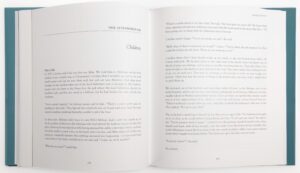“Memoir isn’t the summary of a life; it’s a window into a life, very much like a photograph in its selective composition.”
~ Will Boast, musician and author of the memoir Epilogue
Imagine holding a book that feels like a window into someone’s soul, that offers unfiltered glimpses into the author’s life and makes readers feel like confidants who are along for the ride. Such is the power of a memoir.
Memoirs hold a significant place in literature, with good reason. They provide unique insights into the human condition and enable readers to step into the author’s shoes. Even if just for a moment, they make it possible to experience the world through someone else’s eyes.
In this article, we explore the world of memoir. We examine the definition, purpose, and key elements of the genre, and we offer guidance on how to write a memoir of your own. We also showcase examples of famous memoirs and discuss their impact. Whether you’re an aspiring writer or an avid reader, we hope to deepen your appreciation of the art of memoir and inspire you to delve into this compelling literary form.
What is a memoir?
Memoir is a literary genre that allows writers to share their personal experiences, thoughts, and reflections on specific events or periods in their lives. Unlike a straightforward recounting of facts, however, a memoir delves into the emotional and psychological journey of the author, offering readers a glimpse into their inner world.
Memoirs are characterized by a focus on memory and subjective interpretation, which means that they often blend factual recounting with personal insight and reflection. The goal, in so doing, is not just to inform but to convey the meaning and significance of the author’s experiences.
Many people mistakenly conflate memoir with autobiography. While both genres are forms of life writing, however, they differ significantly in scope and intent:
• An autobiography typically conveys the entirety of a person’s life story in chronological order. It strives for a factual recounting of events and often includes detailed historical and contextual information.
• A memoir is more selective and thematic, typically focusing on specific periods, events, or themes that have impacted the author’s life. Instead of comprehensively covering the author’s life and prioritizing detail and historical accuracy, memoirs tend to capture the essence and impact of moments that have shaped the author’s identity.
Memoirs come in various forms, each with its own unique focus and style. Here are a few common types:
• Personal-growth memoirs focus on their authors’ journeys of self-discovery or personal development and often explore themes of resilience, transformation, and healing. Well-known examples include Elizabeth Gilbert’s Eat, Pray, Love and Cheryl Strayed’s Wild.
• Travel memoirs recount their authors’ adventures around the world and describe cultural insights, personal reflections, and transformative moments encountered during their journeys. Examples include Under the Tuscan Sun by Frances Mayes and Into the Wild by Jon Krakauer.
• Career memoirs offer insights into their authors’ working lives and the economic and political landscapes around them. They provide personal perspectives on decision-making, leadership, and governance. Examples include For the Record by David Cameron and Getting It Together by John Harvey-Jones.
• Celebrity memoirs, written by famous people from fields such as entertainment, sports, and literature, provide an insider’s view of their public and private lives. They often share personal stories, career highlights, and behind-the-scenes revelations. Bossypants by Tina Fey and Born a Crime by Trevor Noah sit in this category.
• Survivor memoirs home in on their authors’ experiences of extraordinary circumstances, such as war, natural disaster, or personal tragedy. They highlight themes of courage, resilience, and the human spirit’s capacity to endure. Examples include Almost Too Late by Elmo Wortman, The Year of Magical Thinking by Joan Didion, and I Am Malala by Malala Yousafzai.
• Photographic memoirs are often the format of choice for individuals with a strong visual storytelling inclination, such as photographers, artists, and those with a deep appreciation for visual media. Family by Chris Verene and Hold Still by Sally Mann are two examples.
Each type of memoir offers readers a lens through which to view the author’s world, providing personal insights and broader cultural or historical context.
Why write a memoir?
People write memoirs for a number of reasons.
Legacy
A memoir can contribute significantly to an individual’s legacy, allowing them to leave behind a detailed account of their life. Through their memoir, an author can also pass down wisdom, values, and life lessons to future generations and a broader audience. This act of sharing can ensure that personal and family histories are preserved and provide a sense of continuity and connection across generations.
Memoirs like Viktor Frankl’s Man’s Search for Meaning and Jeannette Walls’ The Glass Castle serve as legacies that honor their authors’ lives and which also contribute to a wider collective cultural legacy.
Historical documentation
People also write memoirs to document historical and cultural moments from a personal perspective. Unlike traditional historical records that focus on fact, memoirs provide a ground-level view of history as experienced by their authors. These personal perspectives add crucial depth, nuance, richness, and diversity to our understanding of history. They highlight the human experiences
Wartime memoirs such as Władysław Szpilman’s The Pianist, for example, offer moving insights into the human cost of conflict and persecution. Contrastingly, The Anthology, by Jimmy Page, is a dazzling photographic memoir that visually documents the equipment, stage costumes, and tour itineraries of an influential rock musician.
Personal reflection
The writing of a memoir can also serve as a tool for personal reflection and self-discovery.
When authors recount past experiences, they don’t merely list events; they delve into their significance and the impact they’ve had upon their lives. They process emotions and experiences and often gain a sense of closure or acceptance.
Writing a memoir to reflect on and process past events can require courage, but it often leads to a deeper understanding of oneself—an understanding that sometimes reveals patterns, motivations, and lessons that may not have been apparent at the time.
Jean-Dominique Bauby’s The Diving Bell and the Butterfly is one very well-known memoir in which the author reflects poignantly upon the events of his life.
Emotional connection
Some people write memoirs to forge connections with others—perhaps to inspire, to educate, to heal, or to comfort them. Indeed, one of the most compelling aspects of well-written memoirs is their ability to create powerful emotional connections between author and
Dying: A Memoir by Cory Taylor and Educated by Tara Westover, are two memoirs written with the specific aim of forging deep connections with their readers.
The elements of a memoir
For any memoir to be a satisfying read, three aspects of its construction are particularly important: what it looks at, how it “sounds,” and how trustworthy it is.
Themes and focus
Memoirs typically focus on specific themes or periods in their authors’ lives, rather than attempting to cover their entire existence. This focused approach allows for a deeper exploration of particular experiences and their impact on the author.
Memoirs can home in on almost anything, from adversity and identity to love, loss, or hobbies and interests. By centering on specific themes or periods, authors can provide a cohesive narrative that highlights their significance.
To give two examples, Jeannette Walls’ The Glass Castle explores themes of resilience and family dynamics. Barack Obama’s Dreams from My Father focuses on his early life and the exploration of his racial identity and heritage.
Voice and style
The author’s unique voice and narrative style is a critical element of any memoir.
The “voice” in a memoir is the distinctive personality that shines through in the writing, reflecting the author’s character. A strong and authentic voice will always engage readers and make them feel connected to the author’s words.
Narrative style, on the other hand, is all about the author’s choice of language, tone, and structure. The narrative can be lyrical, poetic, straightforward, or journalistic, for instance.
Each memoir’s particular combination of voice and style is what sets it apart and creates a unique reading experience. Contrast, for example, the dreamy, poetic narrative of Just Kids by Patti Smith with the grounded and straightforward nature of Frank McCourt’s Angela’s Ashes.
Truth and honesty
Readers turn to memoirs for genuine insights into the authors’ lives. They expect honest portrayals of events and emotions. Truthfulness and honesty, therefore, are fundamental to memoir writing. This doesn’t mean that every detail must be scrupulously fact-checked to the level of journalism, but the core of the memoir—its emotional and experiential truth—should always be authentic.
Memorably, some memoirists have been “caught out” here. A Million Little Pieces by James Frey and Three Cups of Tea by Greg Mortenson and David Relin, for instance, were both found to contain fabrications and inaccuracies. These revelations greatly damaged the authors’ reputations and their credibility.
Honesty in memoir writing involves not only recounting positive experiences but acknowledging flaws, mistakes, and vulnerabilities. Raw honesty, after all, fosters a deeper connection with readers, who tend to appreciate the courage it takes to reveal one’s true self.
How to write a memoir
Writing a memoir can be a transformative experience that enables you to reflect on your life and to share your unique story. By following a few key steps, you can make yours a compelling and authentic piece of work that resonates with your readers.
Choose a theme
Choosing a central theme for your memoir is the first and most crucial step. You may already know, instinctively, what you wish to focus on. If not, start by reflecting on the most significant experiences and periods of your life. Ask yourself what stories you need to tell and what lessons you have learned.
Your theme should resonate deeply with you and be something that you feel passionate about exploring. It could revolve around your career or your interests, adversities you’ve faced, struggles in finding your identity, or specific events like a significant journey or relationship. The clearer and more focused your theme, the more compelling and cohesive your memoir will be.
Create an outline
Planning the content of your memoir by creating an outline will help you to stay organized and to ensure that your memoir has a clear beginning, middle, and end. It will serve as a kind of roadmap for your writing.
Develop your outline by listing the key events and moments that relate to your theme. Then, organize these events into chronological or thematic sections or chapters, depending on what best serves your narrative, each focusing on a particular aspect or period of your story. Consider including a prologue to set the stage and an epilogue to reflect on your journey.
Write well
Effective writing is essential for bringing your memoir to life. Vivid descriptions will paint a picture for your readers and make them feel as if they are experiencing events with you.
Start by preparing your thoughts and jotting down key moments and emotions that have shaped you. Nudge your memory with prompt questions, photos, and videos to ensure that you leave no stone unturned. Then move on to show—and not just tell—by describing scenes, emotions, and actions in detail. Incorporate dialogue to add depth to your characters and make interactions dynamic and realistic.
If writing doesn’t come easily to you, try priming your creative juices with exercises like free and stream-of-consciousness writing. Sharing your work with others will invite valuable feedback, encouragement, and accountability, so try enlisting the help of family, friends, and mentors.
Remember to be honest and vulnerable in your writing and to share your true feelings and reflections. Your authenticity will resonate with readers and create a more engaging narrative.
Edit, revise … and edit again!
Editing and revision are crucial steps in writing a memoir.
When you’ve completed your first draft, take a break and then revisit your manuscript with fresh eyes. Look for inconsistencies, unclear passages, and areas where you can strengthen the narrative. Focus on clarity, coherence, and impact, and be strong in cutting sentences and paragraphs that don’t serve your themes.
Again, seek constructive criticism from friends, writing groups, or professional editors, and use their feedback to help you refine your memoir. Editing, remember, is not just about correcting mistakes but enhancing the quality and resonance of your story.
Call the professionals
If you struggle to complete any of these steps, consider seeking help from private memoir specialists such as LifeBook Memoirs. Professional memoir writers and editors can help you to develop your theme, organize your content, shape your narrative, and tell your story with clarity and emotion, making the writing process less daunting and more manageable for you.
Working with private memoir specialists can be especially beneficial if you’re short on time or in need of support in bringing your story to life.
Key points
Memoirs are personal narratives that focus on specific experiences or periods in their authors’ lives. They can be photographic as well as textual in nature, and themes can concern anything from personal growth, travel, and career to celebrity and survival. They are written to reflect on life, to document history, to connect with others on an emotional level, and to preserve personal legacies.
Key steps in writing a memoir are choosing a central theme, creating a skeletal outline structure, employing effective writing techniques, and spending time editing and finessing the content. When the challenge of writing or a lack of time impedes progress, there is the option of seeking help from private memoir specialists such as LifeBook Memoirs.
For readers, the memoirs we’ve namechecked here and the countless others that are out there, waiting to be explored, each offer a unique perspective and the chance to walk in someone else’s shoes.
Written by Steve Edwards, LifeBook Memoirs editor





